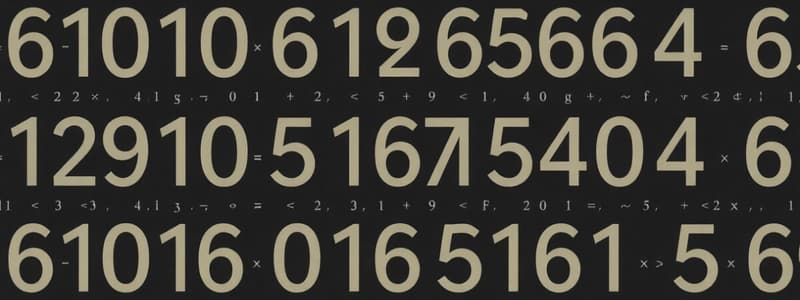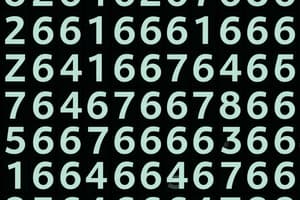Podcast
Questions and Answers
What defines an arithmetic sequence?
What defines an arithmetic sequence?
- Each term is the sum of the two preceding numbers.
- Each term is generated by adding a constant to the previous term. (correct)
- Each term is the product of the previous term and a constant.
- Each term is the square of an integer.
Which formula represents a geometric sequence?
Which formula represents a geometric sequence?
- $ a_n = a_1 \times (n-1) $
- $ T_n = \frac{n(n+1)}{2} $
- $ a_n = a_1 + (n-1)d $
- $ a_n = a_1 \times r^{(n-1)} $ (correct)
What characterizes the Fibonacci sequence?
What characterizes the Fibonacci sequence?
- Each number is the product of the two preceding numbers.
- Each term is generated by multiplying the previous term by two.
- Each number is the sum of the two preceding numbers. (correct)
- Each term increases by a constant amount.
What is the correct formula to find the nth triangular number?
What is the correct formula to find the nth triangular number?
Which of the following is NOT a type of numeric pattern?
Which of the following is NOT a type of numeric pattern?
What is the Commutative Property of addition?
What is the Commutative Property of addition?
Which method involves visualizing addition using movement along a straight line?
Which method involves visualizing addition using movement along a straight line?
What is an example of multi-digit addition?
What is an example of multi-digit addition?
Which property of addition states that adding zero to a number does not change its value?
Which property of addition states that adding zero to a number does not change its value?
What is a common mistake when performing column addition?
What is a common mistake when performing column addition?
Flashcards are hidden until you start studying
Study Notes
Numeric Patterns
-
Definition: A numeric pattern is a sequence of numbers that follow a specific rule or formula.
-
Types of Numeric Patterns:
-
Arithmetic Sequences:
- Each term is generated by adding a constant (common difference) to the previous term.
- Formula: ( a_n = a_1 + (n-1)d ), where:
- ( a_n ) = nth term
- ( a_1 ) = first term
- ( d ) = common difference
-
Geometric Sequences:
- Each term is generated by multiplying the previous term by a constant (common ratio).
- Formula: ( a_n = a_1 \times r^{(n-1)} ), where:
- ( r ) = common ratio
-
Fibonacci Sequence:
- Each number is the sum of the two preceding numbers.
- Starts with: 0, 1, 1, 2, 3, 5, 8, 13...
-
Triangular Numbers:
- Numbers that can form an equilateral triangle.
- Formula: ( T_n = \frac{n(n+1)}{2} )
-
Square Numbers:
- Numbers obtained by squaring an integer.
- Sequence: 1, 4, 9, 16, 25...
-
-
Identifying Patterns:
- Look for common differences (arithmetic).
- Look for common ratios (geometric).
- Analyze terms sequentially to find relationships.
-
Applications:
- Problem-solving in algebra and calculus.
- Recognizing patterns in data analysis.
- Understanding sequences in computer science and programming.
-
Practice Tips:
- Create custom sequences and identify rules.
- Use visual aids like graphs to observe patterns.
- Solve puzzles involving numeric sequences for reinforcement.
Numeric Patterns
- A numeric pattern is a sequence of numbers that follows a specific rule or formula.
- There are different types of numeric patterns, such as arithmetic sequences, geometric sequences, Fibonacci sequences, triangular numbers, and square numbers.
Arithmetic Sequences
- Each term is generated by adding a constant (common difference) to the previous term.
- The formula for an arithmetic sequence is: ( a_n = a_1 + (n-1)d )
- ( a_n ) = nth term
- ( a_1 ) = first term
- ( d ) = common difference
Geometric Sequences
- Each term is generated by multiplying the previous term by a constant (common ratio).
- The formula for a geometric sequence is: ( a_n = a_1 \times r^{(n-1)} )
- ( r ) = common ratio
Fibonacci Sequence
- Each number in the sequence is the sum of the two preceding numbers.
- The sequence starts with: 0, 1, 1, 2, 3, 5, 8, 13...
Triangular Numbers
- Triangular numbers can form an equilateral triangle.
- The formula for triangular numbers is: ( T_n = \frac{n(n+1)}{2} )
Square Numbers
- Square numbers are obtained by squaring an integer.
- The sequence of square numbers is: 1, 4, 9, 16, 25...
Identifying Patterns
- To identify patterns, look for:
- Common differences (arithmetic)
- Common ratios (geometric)
- Sequential relationships between terms
- Visual aids, like graphs, can be helpful in observing numeric patterns.
Applications
- Numeric patterns have applications in various fields including:
- Problem-solving in algebra and calculus
- Data analysis
- Computer science and programming
Practice Tips
- Create custom sequences and identify their rules.
- Use visual aids like graphs to understand patterns.
- Solve puzzles involving numeric sequences to strengthen your understanding.
Definition of Addition
- Combining two or more numbers to find their total.
Properties of Addition
- Commutative Property: The order of numbers doesn't change the outcome (e.g., 2 + 3 = 3 + 2)
- Associative Property: The grouping of numbers doesn't change the outcome (e.g., (2 + 3) + 4 = 2 + (3 + 4))
- Identity Property: Adding zero to a number doesn't change its value (e.g., 5 + 0 = 5)
Types of Addition
- Simple Addition: Adding single-digit numbers
- Multi-Digit Addition: Adding numbers with more than one digit.
- Column Addition: Aligning numbers vertically by place value for addition.
Methods of Addition
- Counting Method: Counting objects or using fingers to find the sum.
- Number Line: Visualizing addition by moving right on a number line.
- Breaking Apart: Separating numbers into smaller, easier-to-add components (e.g., 27 = 20 + 7)
- Estimation: Approximating sums by rounding numbers to the nearest ten or hundred.
Applications of Addition
- Real-life scenarios like budgeting, cooking, and measuring.
- Foundation for more advanced mathematical concepts (algebra)
Practice Strategies
- Mastering basic sums with flashcards.
- Solving word problems to understand real-world application.
- Using interactive games or apps to practice addition skills.
Studying That Suits You
Use AI to generate personalized quizzes and flashcards to suit your learning preferences.




